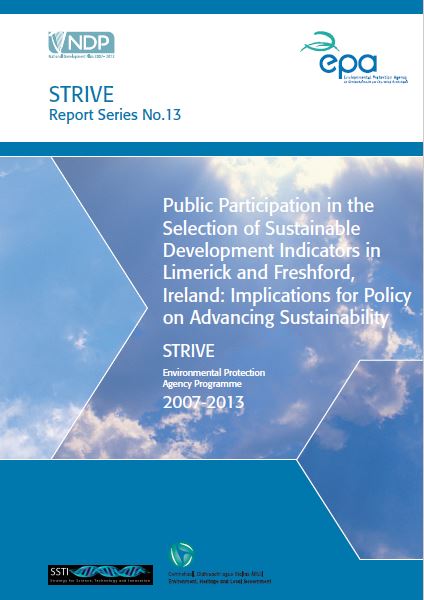Public participation in the selection of sustainable development indicators in Limerick, and Freshford, Ireland
Implications for policy on advancing sustainability Final Report for the ERTDI-funded project: 2004-SD-MS-19
Summary: STRIVE Report 13 - B. O'Regan & R. Moles

Within EU and national policy, there is a recognised need for stakeholders (including business, industry, agriculture, communities and NGOs) to play a more active role in the selection of sustainability indicators as a basis for social, economic and environmental decision making, in the belief that this will lead to more effective policy development and implementation. However, a review of the literature indicated clearly that to date it has proved difficult to develop a method which (i) satisfies decision makers that they have received from stakeholders valid and reliable information on which to base policy initiatives, and (ii) satisfies the public that their views have been actively included in the decision-making process. This project aimed to develop and evaluate the effectiveness of a method for effective stakeholder participation in sustainability indicator selection, and to identify those indicators considered most important by community-based stakeholders. The research reported here was conducted within a city and a village, so that the adaptations necessary to the method, to improve its effectiveness in local circumstances, could be identified. It was found that the participants’ level of understanding of sustainable development issues initially was rather low, to the extent that awareness raising was a vital initiate step. This focused on the interrelatedness among sustainable development, quality of life and industrial/business competitiveness. The participation process successfully increased stakeholder (and hence community) awareness and understanding of issues central to sustainable development. On this basis, stakeholders were able to articulate clearly their own understanding of sustainable development issues, and to select indicators which best represented concerns which they regarded as most important. This project also compared indicators selected by community-based stakeholders with those selected by a group of technical/professional people: while the issues raised in both to some extent overlapped, important differences were evident. Going forward, this method provides a means of integrating stakeholder concerns into both policy making and presentation, so as to enhance wider community understanding of the need for policy development, and encourage greater ‘buy-in’ to the national sustainable development strategy. This will enhance opportunities for successful implementation of existing policy and the introduction of fresh policy initiatives towards sustainability goals.
Also available for download:
Follow this link to view the associated documentation on our SAFER database
- Print-Quality Version (i.e. high resolution PDF) of STRIVE Report 13
- Public participation in the selection of sustainable development indicators in Limerick, and Freshford, Ireland: implications for policy on advancing sustainability. End-of-Project Report (e.g. Final Report). EPA STRIVE Reports are formatted and proofread by the EPA. End-of-Project Reports are prepared and finalised by the authors.